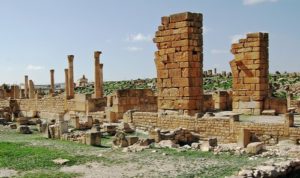This is well off the tourist beat and is a short distance from the Algerian border with ruins scattered across arid scenery. This is the start of the desert. The guide books describe it as a’lonely site and minimally excavated’. This is now out of date as work is being done to stabilise and restore parts of the ruins. The walls separating the stalls in the market area have been rebuilt and still look stark and new as they have not yet had time to weather into the scenery.
This is an old Berber settlement on the trade route between Algeria and Tunisia. It was settled by the Romans in 75AD to suppress a rebellion by the Numidians. The Arch of Septimus Severus at the start of the town survives from this period. When the legions left the area was settle by veterans and the town grew as it became an important trading centre until the arrival of the Arabs in the 7thC.
The site is dominated by the huge Byzantine Fort which was built in the 6thC and is claimed to be the largest in Africa. Its walls still stand 15m high and there are defensive towers built along the walls. There are several gateways into the fort. Inside is a jumbled mass of stones with the remains of a chapel and church on one of the side walls. We drove down to the river to take pictures of the fort and then returned to park on the main street as our driver was worried about leaving us alone as the local kids can be intimidating. Later we did walk down to one of the gateways by ourselves but realised a group of local kids loitering around the fort were approaching us. We weren’t sure how menacing they were but decided to retreat.
Just down from the fort is the ‘building with window’. All that is left is a wall with windows… Beyond are the remains of the cisterns.
Across the road from the Fort are the impressive remains of the Basillica of Melleus which is the largest church on the site built in the 4thC. There are still several pillars standing and carved stones lying on the floor There are inscriptions on some of the paving stones.
There is little left of the Capitol building behind it, just the steps and one pillar is left standing. Next to it the Market area has been partially restored. Behind are the remains of the baths. There are quite extensive remains and they are not in good condition.
What is described as the building with troughs is a short walk beyond. It has a huge building with a courtyard with pillars and a series of stone troughs (with a hole at the back) on a ledge below the arches. Their function is unknown and there is a suggestion they could have been used to store grain.
Behind is square stone Vandal’s Chapel with a few carved slabs lying on the floor. This is important as it is one of the few buildings from the Vandal era to survive.
The arch of Severus marks the start of the town and the remains of the paved road running through it are still visible. It had originally been a splendid carved structure but was covered by massive Byzantine masonry when a defensive wall was built round the town. Part of this has now been removed to expose the Roman work.
Below it near the river stand the remains of the Porticoed mausoleum which is built in the style of a small temple with four columns supporting the roof.
This site is very much off the tourist beat and a long way from anywhere. You have to want to come here. It is very much one for the Roman buffs as apart from the Byzantine Fort there is nothing you won’t have seen elsewhere. Rough Guide refers to the former French Customs Post being slowly renovated to become a museum. Work is still going on. There are no facilities on the site.
It can be done as day trip from El Kef, Sbeitla or Maktar with Jugurtha’s Table (see separate review).









